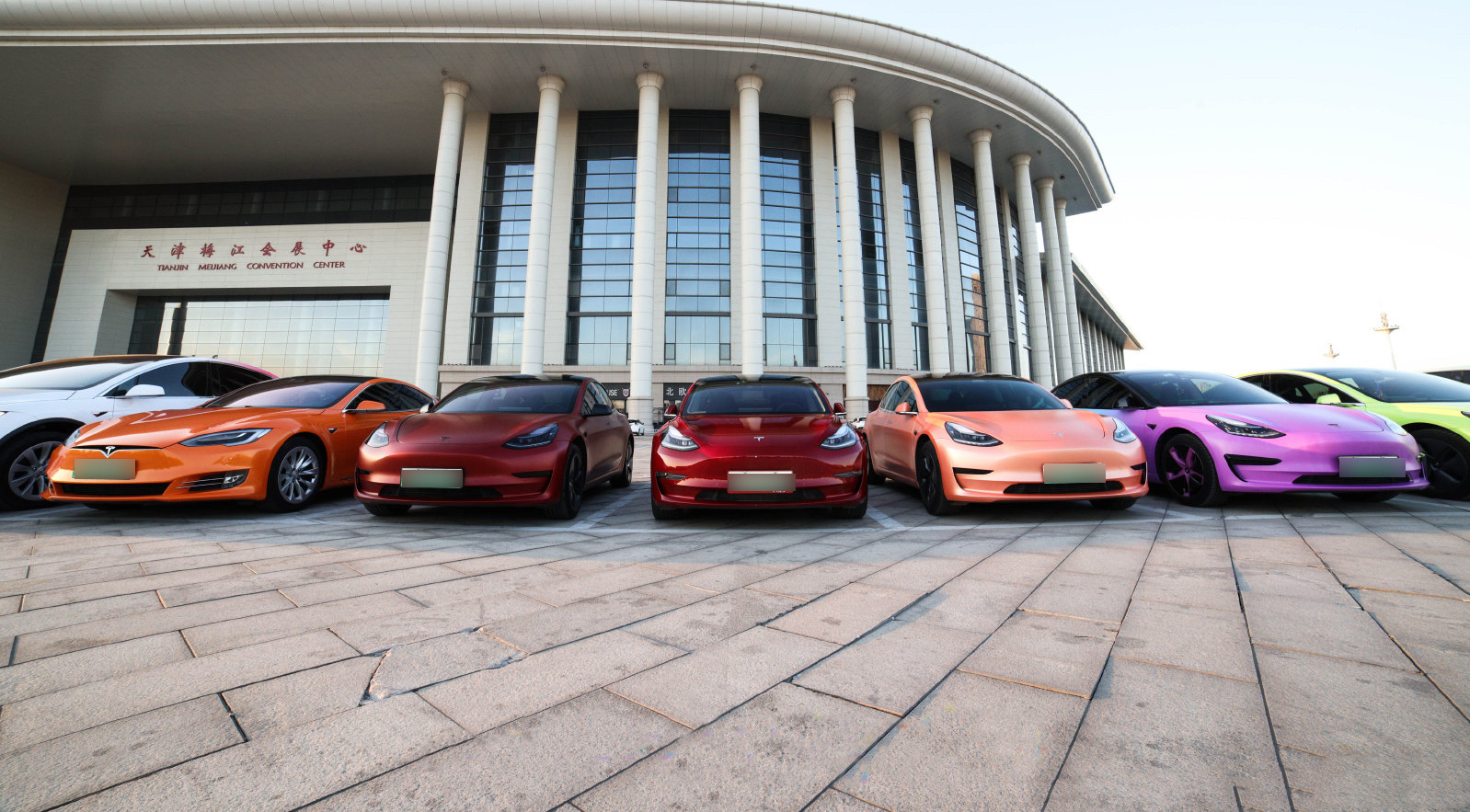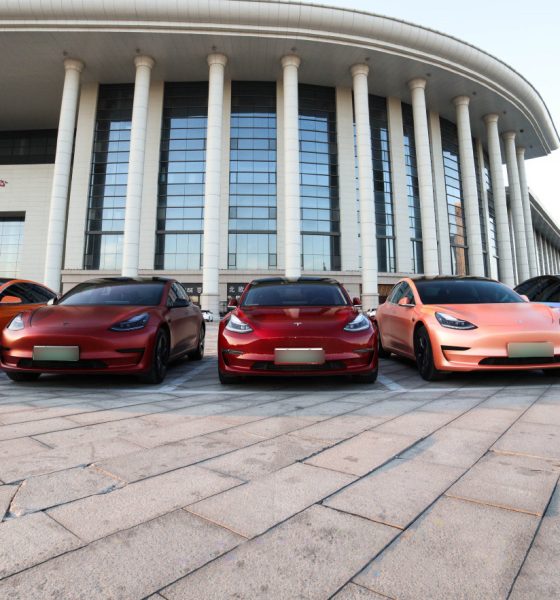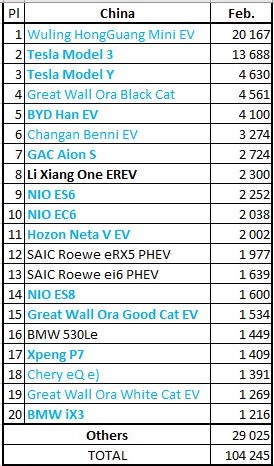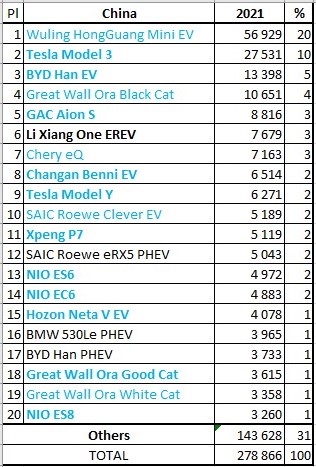

News
Tesla Model 3, Model Y capture silver, bronze medals in China in February
Tesla electric vehicles took the silver and bronze medals in China in February. The Model 3 captured the second-place prize while the Model Y took home the third-place trophy for the month in sales figures. Once again, the Wuling HongGuang Mini EV outsold both of the Tesla EVs to capture the gold in 2021’s second month.
Credit: EV Sales Blog
The Model 3 has been widely popular in China since it was first delivered to customers late last year. The trend has continued for over a year now, and the Model 3 sold 13,688 units in February. The all-electric sedan from Tesla continues to break the 10,000 unit per month threshold, and also outsold several popular gas cars in the overall market, the EV Sales Blog said. The Model 3 beat the Audi A4, the BMW 3-Series, and the Mercedes C-Class in sales for February 2021, showing disruption in the passenger transportation sector.
Meanwhile, the Model Y, first delivered in January 2021, captured the bronze medal in February by selling 4,630 units in February. A reasonable result for the all-electric crossover shows that it is trending upwards and could contribute to the disruption of the gas-powered vehicle market. The EV Sales Blog, who provided these figures, expects the all-electric crossover to peak in Q2 by taking some figures from the Model 3 as some consumers may opt for slightly more cargo space. The Chinese market has not favored crossovers to sedans in recent years. However, the market “is leaning toward higher riding bodies” as of late, and it could be the deciding factor between purchasing a Model 3 or Model Y. Only time will tell how the two siblings perform within the coming months.
RELATED:
Tesla to sell zero cars in China by 2030, Morgan Stanley’s Jonas says
In first place, the Wuling HongGuang Mini EV once again outsold Tesla’s two mass-market cars. In fact, the vehicle managed to sell more units in February than the Model 3 and Model Y combined and extended its gold medal streak to six consecutive months atop the podium. The super-affordable HongGuang Mini EV sells for only $4,400 and seats four people without cargo comfortably. for that price, consumers will sacrifice speed, performance, cargo space, and range as the 9.2 and 13.8 kWh battery packs that the vehicle uses will only offer 120 km (75 mi) and 170 km (110 mi), respectively.
Nonetheless, Chinese consumers are flocking to the affordable GM-produced EV, and projections indicate that the car could sell between 350,000 and 450,000 cars per year.
For the year, the Wuling HongGuang Mini EV has secured the top spot once again with 56,929 units sold in 2021. This accounts for 20% of the total EV market in China. The Model 3 remains in second place with 27,531 units sold so far this year, which is 10% of the market. The Model Y has broken into the Top 10 for sales in 2021, with 6,271 units sold.
Credit: EV Sales Blog

News
Tesla FSD fleet is nearing 7 billion total miles, including 2.5 billion city miles
As can be seen on Tesla’s official FSD webpage, vehicles equipped with the system have now navigated over 6.99 billion miles.

Tesla’s Full Self-Driving (Supervised) fleet is closing in on almost 7 billion total miles driven, as per data posted by the company on its official FSD webpage.
These figures hint at the massive scale of data fueling Tesla’s rapid FSD improvements, which have been quite notable as of late.
FSD mileage milestones
As can be seen on Tesla’s official FSD webpage, vehicles equipped with the system have now navigated over 6.99 billion miles. Tesla owner and avid FSD tester Whole Mars Catalog also shared a screenshot indicating that from the nearly 7 billion miles traveled by the FSD fleet, more than 2.5 billion miles were driven inside cities.
City miles are particularly valuable for complex urban scenarios like unprotected turns, pedestrian interactions, and traffic lights. This is also the difference-maker for FSD, as only complex solutions, such as Waymo’s self-driving taxis, operate similarly on inner-city streets. And even then, incidents such as the San Francisco blackouts have proven challenging for sensor-rich vehicles like Waymos.
Tesla’s data edge
Tesla has a number of advantages in the autonomous vehicle sector, one of which is the size of its fleet and the number of vehicles training FSD on real-world roads. Tesla’s nearly 7 billion FSD miles then allow the company to roll out updates that make its vehicles behave like they are being driven by experienced drivers, even if they are operating on their own.
So notable are Tesla’s improvements to FSD that NVIDIA Director of Robotics Jim Fan, after experiencing FSD v14, noted that the system is the first AI that passes what he described as a “Physical Turing Test.”
“Despite knowing exactly how robot learning works, I still find it magical watching the steering wheel turn by itself. First it feels surreal, next it becomes routine. Then, like the smartphone, taking it away actively hurts. This is how humanity gets rewired and glued to god-like technologies,” Fan wrote in a post on X.
News
Tesla starts showing how FSD will change lives in Europe
Local officials tested the system on narrow country roads and were impressed by FSD’s smooth, human-like driving, with some calling the service a game-changer for everyday life in areas that are far from urban centers.

Tesla has launched Europe’s first public shuttle service using Full Self-Driving (Supervised) in the rural Eifelkreis Bitburg-Prüm region of Germany, demonstrating how the technology can restore independence and mobility for people who struggle with limited transport options.
Local officials tested the system on narrow country roads and were impressed by FSD’s smooth, human-like driving, with some calling the service a game-changer for everyday life in areas that are far from urban centers.
Officials see real impact on rural residents
Arzfeld Mayor Johannes Kuhl and District Administrator Andreas Kruppert personally tested the Tesla shuttle service. This allowed them to see just how well FSD navigated winding lanes and rural roads confidently. Kruppert said, “Autonomous driving sounds like science fiction to many, but we simply see here that it works totally well in rural regions too.” Kuhl, for his part, also noted that FSD “feels like a very experienced driver.”
The pilot complements the area’s “Citizen Bus” program, which provides on-demand rides for elderly residents who can no longer drive themselves. Tesla Europe shared a video of a demonstration of the service, highlighting how FSD gives people their freedom back, even in places where public transport is not as prevalent.
What the Ministry for Economic Affairs and Transport says
Rhineland-Palatinate’s Minister Daniela Schmitt supported the project, praising the collaboration that made this “first of its kind in Europe” possible. As per the ministry, the rural rollout for the service shows FSD’s potential beyond major cities, and it delivers tangible benefits like grocery runs, doctor visits, and social connections for isolated residents.
“Reliable and flexible mobility is especially vital in rural areas. With the launch of a shuttle service using self-driving vehicles (FSD supervised) by Tesla in the Eifelkreis Bitburg-Prüm, an innovative pilot project is now getting underway that complements local community bus services. It is the first project of its kind in Europe.
“The result is a real gain for rural mobility: greater accessibility, more flexibility and tangible benefits for everyday life. A strong signal for innovation, cooperation and future-oriented mobility beyond urban centers,” the ministry wrote in a LinkedIn post.
News
Tesla China quietly posts Robotaxi-related job listing
Tesla China is currently seeking a Low Voltage Electrical Engineer to work on circuit board design for the company’s autonomous vehicles.

Tesla has posted a new job listing in Shanghai explicitly tied to its Robotaxi program, fueling speculation that the company is preparing to launch its dedicated autonomous ride-hailing service in China.
As noted in the listing, Tesla China is currently seeking a Low Voltage Electrical Engineer to work on circuit board design for the company’s autonomous vehicles.
Robotaxi-specific role
The listing, which was shared on social media platform X by industry watcher @tslaming, suggested that Tesla China is looking to fill the role urgently. The job listing itself specifically mentions that the person hired for the role will be working on the Low Voltage Hardware team, which would design the circuit boards that would serve as the nervous system of the Robotaxi.
Key tasks for the role, as indicated in the job listing, include collaboration with PCB layout, firmware, mechanical, program management, and validation teams, among other responsibilities. The role is based in Shanghai.
China Robotaxi launch
China represents a massive potential market for robotaxis, with its dense urban centers and supportive policies in select cities. Tesla has limited permission to roll out FSD in the country, though despite this, its vehicles have been hailed as among the best in the market when it comes to autonomous features. So far, at least, it appears that China supports Tesla’s FSD and Robotaxi rollout.
This was hinted at in November, when Tesla brought the Cybercab to the 8th China International Import Expo (CIIE) in Shanghai, marking the first time that the autonomous two-seater was brought to the Asia-Pacific region. The vehicle, despite not having a release date in China, received a significant amount of interest among the event’s attendees.








